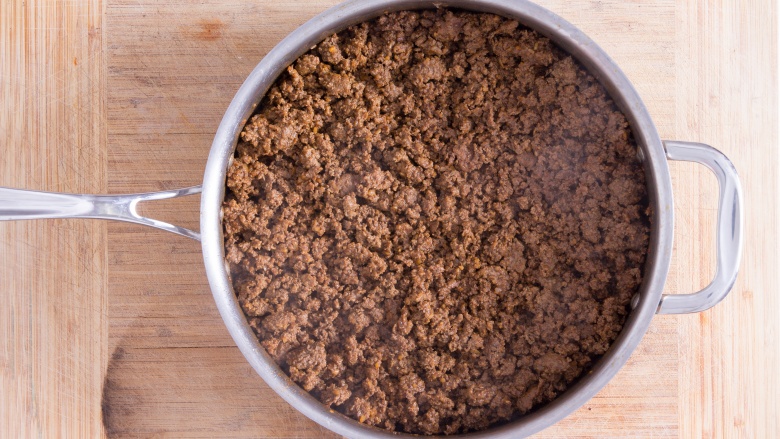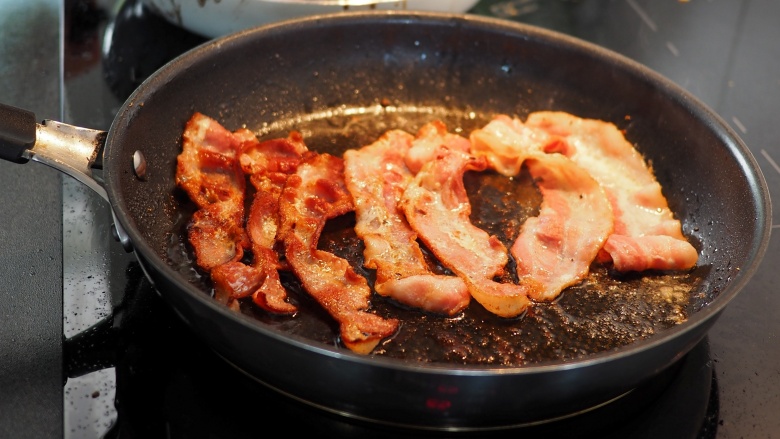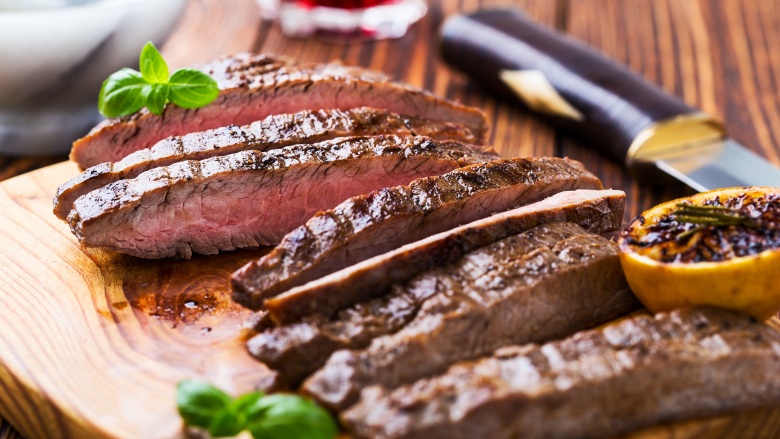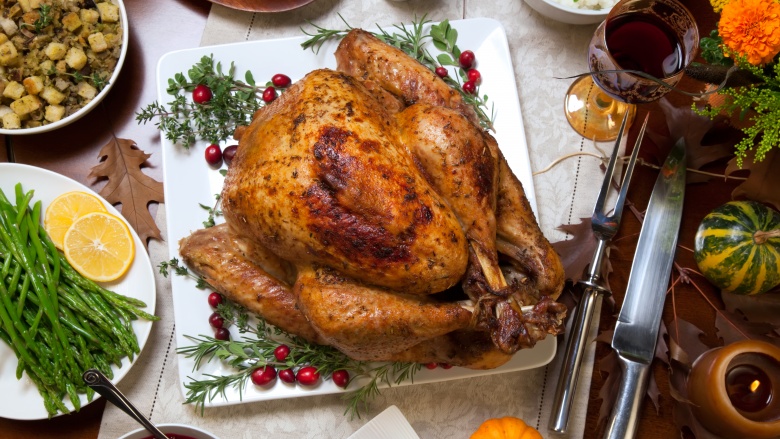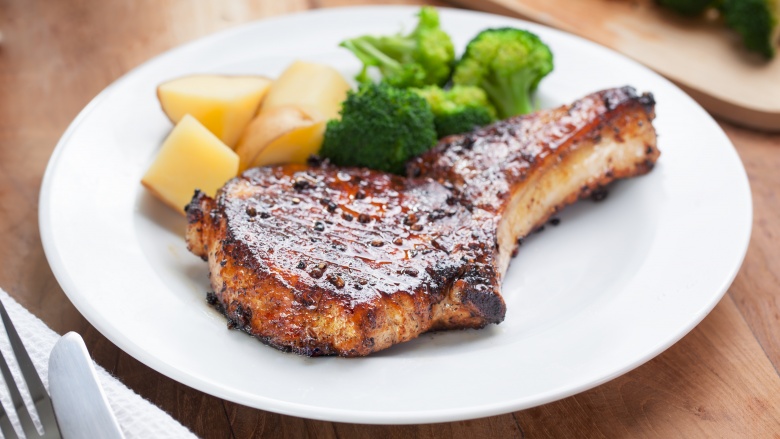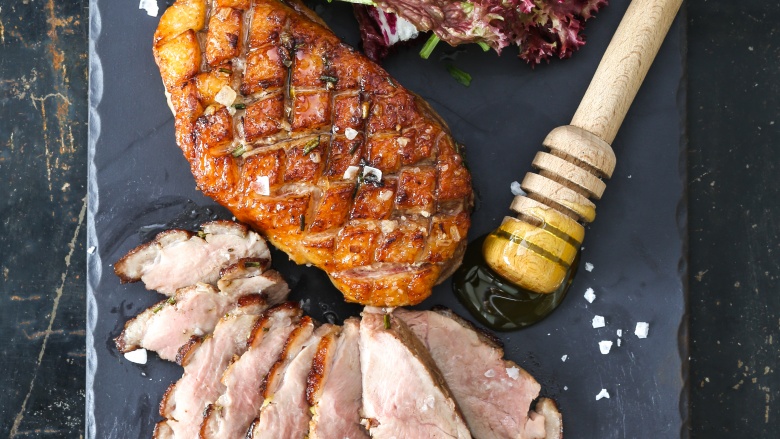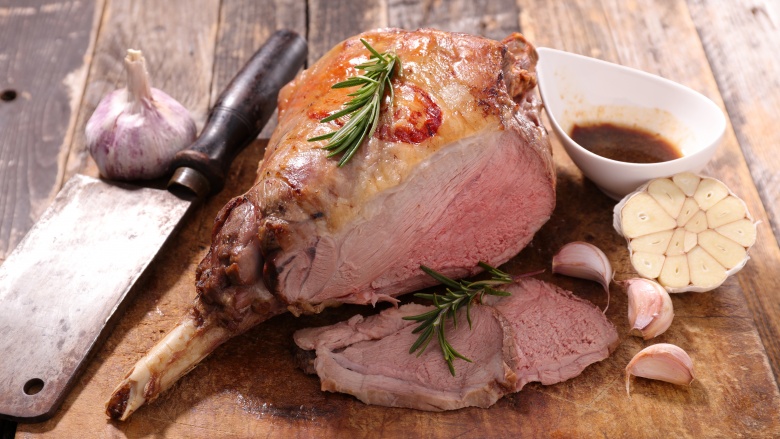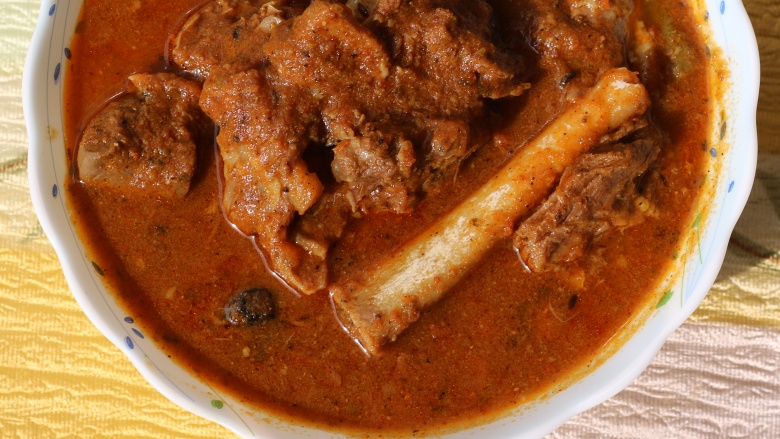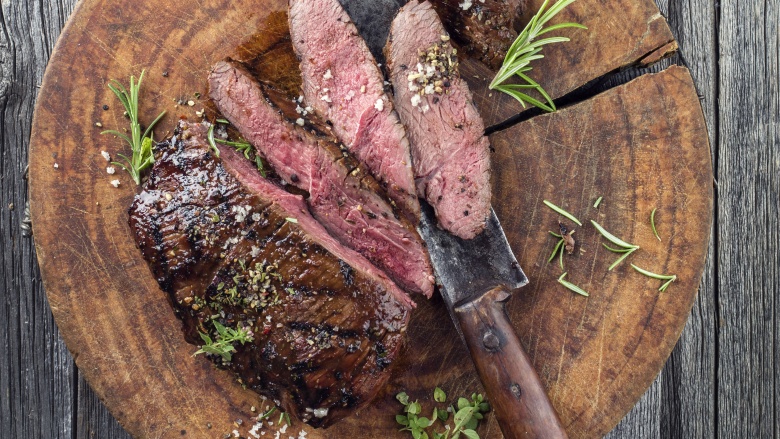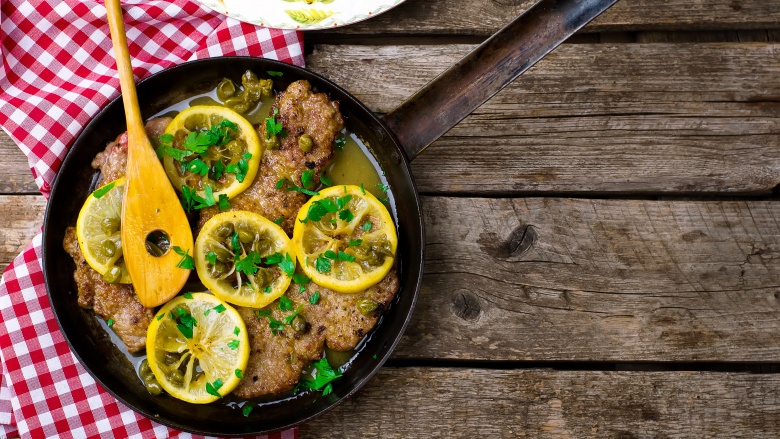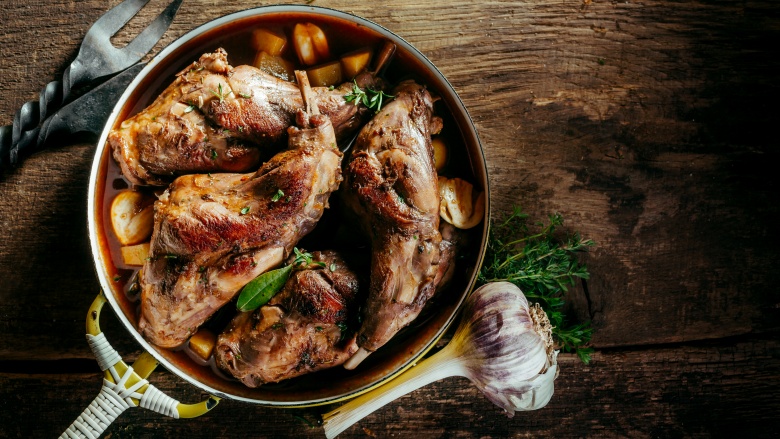The One Thing You Should Do Before Cooking Meat
While I am head over heels about seasonal vegetables and their multitude of colors, flavors, and textures, my body requires a well-balanced diet that includes protein in order to keep chugging along. As such, I've made it a priority in my adult years to learn how to cook meat properly. If you also want to incorporate various types of protein into your cooking routine but feel intimidated by the prep, I urge you to set aside your fears.
Few meals induce more personal pride and general satisfaction than the ones headlined by beautiful glazed pork chops, enviably juicy steaks, or artfully scored duck breasts. While it might be much easier to get your meaty fix by eating out, you'll do your bank account a big favor by making these tasty and nourishing dishes at home. Don't fret if you're a novice at handling meat and poultry!
Before you get started, the one thing you really should do is study up on the type and cut of meat you're using. Not all cuts are created equal, and the best cooking methods can vary greatly, depending on what you're working with. I've narrowed down some important meat cooking tips that have helped me feel more confident in the kitchen over the years. With a bit of know-how and desire to experiment, you'll be on your way to delicious restaurant-caliber meals in no time.
Pound chicken breasts to an even thickness for perfection every time
While there are countless tips for how to cook chicken, here, I want to give you a key one for preparing the most common cut: the breast. Cooking big and small pieces together guarantees uneven results. To get reliable results, make sure all the chicken pieces you cook together are of the same size and thickness.
If you are cooking chicken breasts that are uneven in size, place them between two sheets of plastic and using a meat mallet or heavy object, pound them down until they are roughly equal. This easy step ensures the breasts will cook evenly in the pan.
Practice pounding chicken with this traditional paillard recipe from Martha Stewart. Thinly pounded chicken breasts are pan-seared and served with a pan sauce made with stock and lemon juice. Dinner couldn't be any easier.
Brown ground beef in oil
A great variety of recipes call for browned beef as a component—bolognese, tacos, and shepherd's pie to name a few. While it seems easy enough, sometimes cooking ground beef can render it hard and dry. Since no one wants to bite into clumps of hardened meat, I suggest utilizing a little extra fat to keep the beef moist.
As most people prefer to buy lean ground beef for health reasons, there's sometimes just not enough fat in it. If little fat is rendered during the cooking process, the meat tends to dry out. To prevent this tragedy, try adding a splash of oil to the pan. You can also use bacon fat or lard if you have some on hand. The idea is that you want to incorporate small amounts of moisture into the meat over the period of time it takes to fully brown the beef.
This recipe from The Kitchn helps guide you through the basic process of browning ground beef. It's easy peasy! While the small amount of neutral cooking oil is cued as optional, I highly recommend using some, especially if you are working with very lean meat.
Start cooking bacon in a cold pan
As far as I'm concerned, crispy bacon is the only kind of bacon I want to eat. Chewy just doesn't do it for me. To get perfectly crisp strips of pork without burning them, it's crucial to start cooking them in a cold pan. While it may seem intuitive to heat a pan before adding ingredients, bacon is the one instance in which a cold pan start is preferable.
Starting bacon in a hot pan causes it to burn before all the fat has fully rendered. To get the best results, start with a cold cast iron skillet. Add the bacon, then turn the heat to medium. Doing so gives the fat plenty of time to melt away as the bacon cooks.
Let this easy recipe from The Kitchn guide you toward better bacon. It starts with the cold pan and ends with the ridiculously crispy, perfectly rendered bacon strips. Enjoy as a snack or alongside eggs and toast. Whatever you do, the foundation for how to cook excellent bacon will always be with you.
Dress steak handsomely
Since good steak doesn't come cheap, you definitely want to treat it with great care. When it comes to prep, that means dressing them well — or, season like a pro. It's true that a high-quality steak doesn't need much to make it shine, however, it can certainly benefit from a little TLC. While cooking a good slab of meat on a grill lends it a lot of naturally robust flavors, steak definitely requires deft seasoning to take it from mediocre to fabulous.
Before adding the steak to the grill, be sure to consider your seasoning options. Salt and pepper are perfectly acceptable, but you can also go fancier if you feel like it. Think paprika, onion and garlic powders, or cayenne pepper. Simply brush both sides of the steak with a modest amount of oil and sprinkle your seasonings all over. Handsome and dressed for the occasion, you're now ready to throw it on the sizzling grill.
If anyone knows his steak, it's steakhouse restaurateur Bobby Flay. Here, Flay's recipe for Food Network gives a nod to straightforward, unfussy elegance. Boneless ribeye (or New York strip) is brushed with neutral oil and generously seasoned with only salt and pepper. Grilled to an optimum medium rare, this dish goes to show that it doesn't take a lot to eat fancy at home.
Season turkey inside and out
Roasting a whole turkey seems daunting, but trust me, it's very easy to do. One of the keys to cooking this hefty bird is seasoning it well from the inside out. While there are times you want to use a light hand, roasting turkey is not one of those times. Be sure to dry it well and season the skin generously — as well as the cavity.
Be creative when you season. Sure, salt and pepper are great for the exterior, but what about inside the bird? The cavity is a great place to infuse fragrant seasonings that enhance the flavor of the meat. You can try using fresh or dried herbs as well as sliced garlic and other spices.
I like this recipe from Ina Garten for Food Network, because it pares down the turkey roasting process, making it down-to-earth and doable. She stuffs the cavity with onion, garlic, thyme, and lemon for classic flavors that work every time.
Brine pork chops because you care
If you've ever eaten a poorly cooked pork chop, you'll understand how disheartening the experience can be. Dry and leathery, the meat tastes like a well-worn pair of leather shoes. Gross! Well, it's high time you move on from those unsavory experiences and discover how delectably moist and tender pork can be when it's properly prepped before cooking. The secret to achieving juicy pork? One word: Brine.
Whether you have 30 minutes or many hours to spare before cooking the pork chops, giving them a quick brine will help to improve the cooked results tremendously, banishing any fear of dry meat. You can use a simple salt brine or infuse your brining liquid with other aromatics such as lemon rinds, peppercorns, or garlic. Whatever you decide to throw in, the liquid will lock in some of the meat's moisture, while the seasonings will lend depth of flavor to the interior of the meat.
This recipe from Bon Appetit takes the brined pork chops concept to the next level by using a longer brining period. The liquid comprises water, sugar, peppercorns, juniper berries, garlic, and thyme for a festive flavor infusion you won't be able to resist. When you're ready to cook your chops, simply give them a quick pan sear before finishing off the cooking inside the oven. This easy recipe results in pork that's seductively glazed on the outside from the sugar in the brining liquid and impossibly tender on the inside. #Flawless
Score duck to distribute the fat
Duck may seem like a luxurious (and culinarily challenging) choice for a weeknight dinner, but I'd like suggest otherwise. You are more than capable of cooking a succulent piece of duck breast right in your own kitchen. Since duck breast naturally has a layer of fat beneath the skin, part of your prep includes figuring out how to remove some of this fat without hacking up the piece of meat. The time-tested way to do that is by scoring the duck.
In magazine spreads featuring duck breast, you'll notice a lovely crosshatched diamond pattern etched into the skin. These marks are created by scoring, which entails using a sharp knife to cut lines through the skin and fat, being careful to avoid cutting through the meat. Doing so allows that layer of fat to render and redistribute during cooking, since no one wants to bite into a hunk of fat.
Practice your duck scoring skills with this deceptively fancy-pants recipe from Epicurious. Use your sharpest knife to score the skin, then season with salt and pepper and cook in a large skillet. Once the duck finishes cooking, keep it warm in the oven while you whip up an earthy mushroom and red wine reduction in the pan. No biggie!
Remove lamb chops from the fridge one hour before cooking
There's something so celebratory and festive-feeling about serving up a leg of lamb, in my humble opinion. From the unbeatable flavor to the tender meat, it's no wonder this is the go-to centerpiece for Easter and Passover. If you've never roasted a leg of lamb, I fully understand your trepidation. Big and pricey, you're naturally worried about screwing it up. My one word of advice is to take the meat out of the refrigerator at least one hour before you plan to cook it.
The small step of setting the lamb out at room temperature for at least an hour is a tiny step that makes a huge difference. As leg of lamb — the back part of the animal's haunch — is massive, bringing it to room temp allows the meat to cook faster and more evenly.
This recipe from The New York Times keeps the process streamlined, should this be your first time handling leg of lamb. Slathered with butter and anchovies, the meat is roasted until tender and served with the most addictive jus made with pan drippings. The result is a dramatic lamb presentation that promises to be stunning.
Marinate mutton and wild boar so you don't break your jaw chewing
Cooking mutton and wild boar presents the challenge of making the meat tender as both are naturally tough and chewy. People put up with their finicky ways because the flavors are incredibly unique and robust when the meats are cooked well. To keep these tougher meats tender, enlist the help of marinades.
Marinating is a crucial part of preparing mutton and wild boar. Yogurt is ideal for marinating these meats since it renders them softer and helps them to cook more quickly. Acidic ingredients such as vinegar can also lend great flavor and moisture to a marinade. If you like, experiment with a blend of yogurt, mustard, and spices to see what works for your palate.
This savory recipe from Indian Healthy Recipes presents the ideal preparation for mutton, maximizing its texture and flavor. Marinated in yogurt, turmeric, garlic paste, and chili powder, the meat is cooked with a delicious, warmly spiced tomato-based curry.
Season venison, but don't cover up its unique flavor
One of the most sustainable meats in the world, venison is a great protein choice for a variety of preparations. Leaner than other meat options and full of vitamins, it possesses a unique earthy flavor that pairs well with many herbs and spices, as well as heirloom produce. While venison is often described as tasting "gamey," that's merely its natural flavor. Since deer forage for their food, they consume berries, grass, acorns, and the like. Of course their flavor will be different than that of corn-fed cows! Instead of masking venison's flavor, try embracing it.
With more tender cuts of venison such as backstrap or loin, I suggest opting for deliberately simple seasonings like olive oil, salt, and pepper. Using minimal extras allows the flavor and taste of the meat to come through. Trust me — it's delicious!
This recipe from Hunter Angler Gardener Cook celebrates the flavor of venison instead of hiding it. It's a take on classic steak Diane, which normally features beefsteak. Not anymore! Here, venison medallions are pan-seared and served with a rich and fragrant pan sauce. You may want to use bread to soak up every last bit.
Trim excess membrane around veal cutlets to prevent curling
Full of protein, leaner than poultry, and super tender, veal belongs on everyone's dinner rotation. Whether you're sauteing, broiling, or stir-frying, this apprehensive meat will certainly curl up at the edges if you don't prep it for the heat. By doing a little trim work, you'll avoid this unfortunate turn of events.
To prevent veal cutlets from curling up around the edges, be sure to carefully trim away the fat and membrane around the slices. This one extra step between bringing them home from the butcher shop and cooking makes a world of difference presentation-wise.
Check out this veal piccata recipe from Food Network for an easy way to enjoy this underrated meat. This classic Italian-American preparation is simple and satisfying. Here, veal cutlets are dredged in seasoned flour and pan-fried, then served with a briny pan sauce made with wine, stock, and capers.
Opt for bone-in to ensure moist rabbit meat
Rabbit is a great choice if you want to change up your meat game. If you can get over the weird feelings people tend to have about consuming this type of meat, you'll discover it's a lean and flavorful option that can be well-suited to quick weeknight preparations. In a lot ways, preparing rabbit is similar to preparing chicken. As with the latter, bone-in cuts tend to yield more flavorful meat.
While you can certainly de-bone rabbit, I suggest cutting it into smaller pieces for cooking but leaving the bones intact. Doing so lends the delicate meat a more robust flavor profile.
This recipe from D'Artagnan is a classic one that never goes out of style. Roasted rabbit is served with a rich sauce made with mustard, creme fraiche, garlic, and bacon. The result tastes distinctly French and rustic.
With these meaty tips in mind, I'm confident you'll have a grand old time fixing yourself all kinds of five-star dinners.


